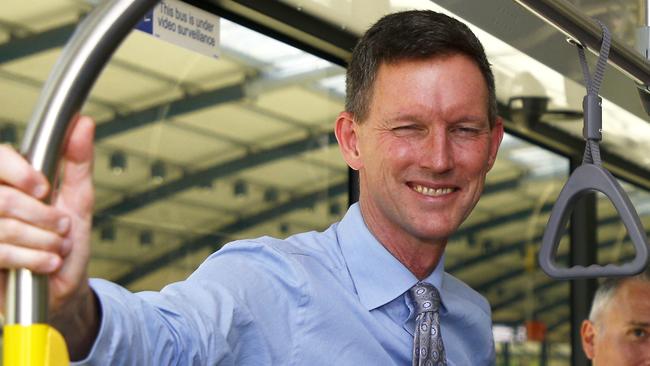Editorial: Mark Bailey bites the dust – six years too late
Mark Bailey’s ministerial career should have ended six years ago after the infamous mangocube email scandal, writes the editor.

Opinion
Don't miss out on the headlines from Opinion. Followed categories will be added to My News.
Mark Bailey has resigned from state cabinet, having jumped before he was pushed by incoming premier Steven Miles.
But Mr Bailey’s ministerial career should have ended six years ago when he was found to have used a private email account – that he later deleted – to discuss government business.
While Mr Bailey was later cleared of wrongdoing by the Crime and Corruption Commission, what should have mattered more for Premier Annastacia Palaszczuk at the time was that he did it at all.
But she stuck with him.
Fast forward six years and Mr Bailey has become the Palaszczuk government’s most controversial minister – having presided over a growing list of cost blowouts in his Transport portfolio.
In fact, they were so common that some observers were seriously suggesting that perhaps he spent too much time on the social network platform formerly known as Twitter, and not enough time being across his portfolio.
But Mr Bailey was not only a questionable steward of taxpayers’ money. He was also caught this year withholding from taxpayers a blowout in the government’s train manufacturing program.
He quite simply had to go.
BOUNCING BACK FROM JASPER
North Queenslanders possess a collective trait demonstrated time and again over the years: they can face down a cyclone.
As Cyclone Jasper continues its onslaught across Cape York and towards the Gulf of Carpentaria today, the people of the Far North will be cleaning up, checking on neighbours, assessing their losses, counting their blessings and getting on with their lives – just as they have always done.
There is a powerful community resilience in North Queensland when it comes to cyclones that is not the stuff of mere folklore, myth or legend. It’s a trait demonstrated through the generations as these storms arrive with the summer and threaten lives and property, businesses and public buildings, crops and livestock.
This stoicism in the face of adversity was there well before Federation when Cyclone Mahina, the deadliest cyclone in Australia’s recorded history, struck Bathurst Bay on Cape York Peninsula in March 1899 – taking between 300 and 400 lives.
It was there again in January 1918 when the sugar town of Mackay was flattened by an unnamed cyclone which spread itself southward down the coast to Rockhampton, claiming 30 lives and pouring 1141mm of rain on Mackay over three days – creating devastating flooding as the Pioneer River burst its banks.
In recent decades Queenslanders have lived through (among others) Cyclone Winifred in 1986, Cyclone Justin in 1997, Cyclone Ingrid in 2005, Cyclone Larry in 2006 and Cyclone Yasi in 2011.
In the aftermath of each disaster that tough and steadfast North Queensland spirit has immediately manifested itself as emergency services click into high gear and neighbour helps neighbour to clean up, rebuild and resume life in the Tropical North.
And the North has, for more than half a century, not been content to simply batten down and rebuild. Determined efforts have been made to examine new building methods to create infrastructure better placed to withstand cyclonic winds.
That approach can be traced directly back to Cyclone Althea, which struck Townsville and nearby Magnetic Island in 1971.
The then vice-chancellor of Townsville’s James Cook University, Ken Back, offered the fledgling university’s engineering expertise to help improve housing construction which led to new building standards which continue to serve Queensland to this day.
The then Queensland Labor government built on that philosophy after the 2010-11 Summer of Disaster. The new Queensland Reconstruction Authority under Major General Mick Slater was determined not to recreate the buildings which succumbed quickly to floods and high winds, but to rebuild better and stronger to increase Queensland resilience to natural disaster.
The theme was continued by the Newman government’s local government minister (now Opposition Leader) David Crisafulli who oversaw reconstruction of community infrastructure across the state, which is far better placed to withstand future storm and flood.
The trepidation felt by a community as a storm descends, and the helplessness felt when nature appears to descend into a howling chaos, is never forgotten by people who have experienced a tropical cyclone.
But like the pandanus palms, the sugar cane fields and those beautiful clusters of banana fronds that so often dot backyards, they will always be part and parcel of life in the Tropical North.
Cyclone Jasper may derail people’s lives temporarily. But those affected can rest assured there will be plenty of helping hands ready to get them back on track in a strong and steadfast community which has learned a great deal about dealing with the pandemonium of the natural world, and has never yet been bowed into submission by a tropical cyclone.
Responsibility for election comment is taken by Chris Jones, corner of Mayne Rd & Campbell St, Bowen Hills, Qld 4006. Printed and published by NEWSQUEENSLAND (ACN 009 661 778). Contact details here




